This article needs additional citations for verification .(August 2019) |


Hango Hill is an historic mound on the coast road between Castletown and Derbyhaven, Malew parish, Isle of Man.
This article needs additional citations for verification .(August 2019) |


Hango Hill is an historic mound on the coast road between Castletown and Derbyhaven, Malew parish, Isle of Man.
The mound is said to be a possible prehistoric burial site. The recovery of a bronze flat axe implies a possible Bronze Age date. [1] Its name derives from the Norse hanga-haugr, "Gallows hill". [2]
Hango Hill was used as a place of execution at least until the 17th century. An entry in the burials register of Malew for 1604 states that William Keruish and Robert Calow, from Kirk Maughold, for the murder of a certain Cottscam of that parish, were hung at the Hango Hill gallows on 31 August and buried in the church of Kirk Malew, in front of the porch. [3] It is most famous as the execution site of Illiam Dhone (William Christian) in January 1663, for his part in the Manx rising of 1651 against the Derby family [4] and there is a broken-down monument with a plaque commemorating this. However the history is rather more complicated than that, as the island had been invaded by Parliamentary forces of the English Civil War.
The monument is said to be the remains of a late 17th century summerhouse, or hall, known as Mount Strange, after a subsidiary title of the Earls of Derby.
A hall was built on the summit of Hango Hill by the earls of Derby in the years following the execution of William Christian in 1663. The hall was about 10m in length, but now[ when? ] only about a third survives following the erosion of the coastline. Early drawings show a building with battlements, and it has been referred to as a "blockhouse"; it seems however only ever to have served as a banqueting hall and a summerhouse, and it was associated with horseracing organised by the Earls along the dunes to the east onto Langness – the first "Derby" races. [5]
The erection of this building would appear to imply that the site ceased to be used as a place of execution. Certainly by the 19th century, executions were being carried out at Castle Rushen nearby. [6]
The estate of Hango Hill was placed in the hands of trustees by Bishop Barrow in 1668 for the purpose of founding an educational institution on the island; much later, the trust founded King William's College, which lies across the road from the mound itself. [7]
A Committee of the Tynwald Court was appointed to consider what steps should be taken to preserve the ancient monuments at Hango Hill. It reported in November 1891. [8]
A picture of Hango Hill was featured in a set of Manx Revenue stamps issued in 1966. [9]
It is occasionally used as a gathering-place by Manx nationalists, [10] with an annual speech in the Manx language.
The site is promoted as a film location. [11]
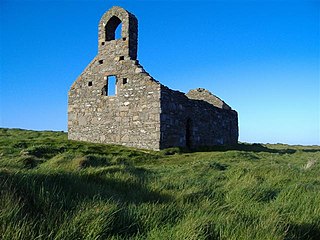
St Michael's Isle, more commonly referred to as Fort Island, is an island in Malew parish in the Isle of Man, noted for its attractive ruins. It covers an area of 5.14 hectares, is about 400 metres long from west to east, and is connected to the Langness Peninsula, near Derbyhaven, by a narrow causeway. The island itself is made of rocky slate and the soil is very acidic. Nevertheless, it has important communities of maritime plants.

Castletown is a town in the Isle of Man, geographically within the historical parish of Malew but administered separately. Lying at the south of the island, it was the Manx capital until 1869. The centre of town is dominated by Castle Rushen, a well-preserved medieval castle, originally built for a Viking king.

Peel is a seaside town and small fishing port in the Isle of Man, in the historic parish of German but administered separately. Peel is the third largest town in the island after Douglas and Ramsey but the fourth largest settlement, as Onchan has the second largest population but is classified as a village. Until 2016 Peel was also a House of Keys constituency, electing one Member of the House of Keys (MHK), who, from September 2015, was Ray Harmer. Peel has a ruined castle on St Patrick's Isle, and a cathedral, seat of the Diocese of Sodor and Man.
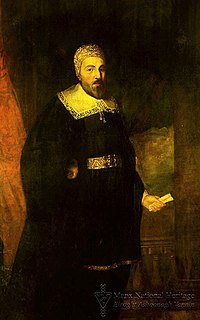
Illiam Dhone or Illiam Dhôan, also known as William Christian, was a Manx politician and depending on viewpoint, patriot, rebel or traitor. He was a son of Ewan Christian, a deemster. In Manx, Illiam Dhone literally translates to Brown William—an epithet he received due to his dark hair, and in English he was called Brown-haired William. Dhone was a significant figure in the Isle of Man during the English Civil War and the Manx Rebellion of 1651. He was executed for high treason in 1663. In the centuries after his death he has become a "martyr and folk-hero, a symbol of the Island's cherished freedoms and traditional rights".
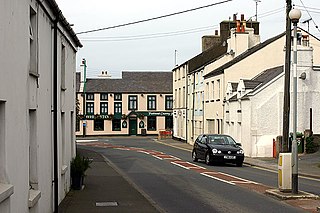
Ballasalla is a village in the parish of Malew in the south-east of the Isle of Man. The village is situated close to the Isle of Man Airport and 2 miles (3 km) north-east of the town of Castletown.

Ballabeg is a village on the Isle of Man. It is in the parish of Arbory in the sheading of Rushen, in the south of the island near Castletown. There are several small villages and hamlets with the name, although Ballabeg in Arbory is the most well-known and populous.

Derbyhaven is a hamlet near Castletown in the southern parish of Malew, Isle of Man. It is located on the isthmus connecting Langness Peninsula to the rest of the island, on the bay of the same name, and also on Castletown Bay on the other side of the isthmus.
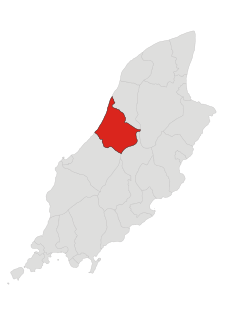
Michael is one of the six sheadings of the Isle of Man. It is located on the west of the island and consists of the three historic parishes of Ballaugh, Jurby and Michael.
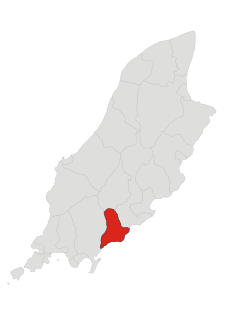
Santon, historically Santan, is one of the seventeen historic parishes of the Isle of Man.

Andreas is one of the seventeen parishes of the Isle of Man. It is located in the north of the island in the sheading of Ayre. The main settlement in the parish in the village of Andreas, which is also known as Kirk Andreas.
Keeill is a Manx Gaelic word for a chapel.
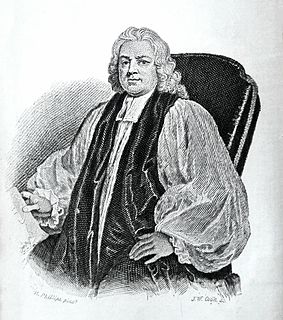
Thomas Wilson was Bishop of Sodor and Man between 1697 and 1755.
A moot hill or mons placiti is a hill or mound historically used as an assembly or meeting place, as a moot hall is a meeting or assembly building, also traditionally to decide local issues. In early medieval Britain, such hills were used for "moots", meetings of local people to settle local business. Among other things, proclamations might be read; decisions might be taken; court cases might be settled at a moot. Although some moot hills were naturally occurring features or had been created long before as burial mounds, others were purpose-built.

Andreas or Kirk Andreas is a village on the Isle of Man, lying in the north of the island, 5 km from the island's second town, Ramsey. There is a large, and nowadays little used, airfield in the vicinity.

Rendall is a parish on Mainland, Orkney, Scotland. It is in the north west of the island and lies east of the parishes of Birsay and Evie and north east of Harray. The island of Gairsay is also in the parish.

Chapel Hill, Balladoole is a significant historical and archaeological site in Arbory on the Isle of Man. The site is a short distance from Castletown in the south of the Island. It is located on a small hilltop overlooking the coast. Balladoole has undergone extensive archaeological excavations in the 20th century, most notably in 1944-1945 by German archaeologist Gerhard Bersu who was interned on the Isle of Man during World War II.
Ewan Christian was a Manx politician and landowner on the Isle of Man. He held the position of deemster for 51 years from 1605 until his death. He also held the position of Deputy-Governor of the Isle of Man 1634 to 1637. He was the father of controversial Manx political revolutionary and folk-hero Illiam Dhone.
The Manx Rebellion of 1651 was an uprising against the ruler of the Isle of Man during the English Civil War. It was led by William Christian, better known by the epithet Illiam Dhone, due to his dark hair. The Rebellion was mainly in response to agrarian and land ownership reforms enacted by Lord of Mann James Stanley, 7th Earl of Derby, and the increased burden on the Manx people during the English Civil War. It was a bloodless coup with English Parliamentary forces taking control of the island. The Rebellion temporarily ended control of the Isle of Man by the Stanley family until the Restoration when King Charles II returned from exile in Europe.

Knock y Doonee is a significant historical and archaeological site in the parish of Andreas on the northern coast of the Isle of Man. The site has been in ritual use for centuries. Archaeological excavations have uncovered a Christian keeill with a bilingual ogham stone and a Christian carved stone cross; and on a nearby hilltop a Viking Age boat burial.

Ballavarry Burial Mound is a Bronze Age burial mound in the parish of Andreas on the Isle of Man. It is located by Ballavarry farm entrance on a low hill, a short distance from Andreas village. The mound is significant and survives to a height of 3m and a diameter of 15m.